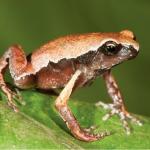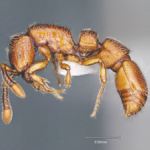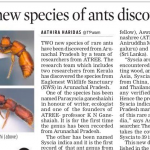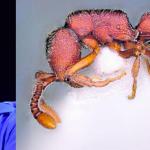ATREE News

Dancing, starry dwarf and narrow-mouthed: new species make India a frog paradise
One of Aravind Madhyastha’s most fascinating finds was in a timber yard in Mangalore on India’s western coast – a narrow-mouthed frog called Microhyla kodial, whose closest relative is found only in Myanmar.

Bengaluru scientists discover 2 new ant species in Arunachal
With ATREE celebrating its silver jubilee this year, one species is named as Parasyscia ganeshaiahi, in honour of one of one of its founders prof K N Ganeshaiah. He is an eminent ecologist, agricultural scientist and retired professor of University of Agricultural Sciences, Bengaluru. The other species, the first record of that ant genus in India, was named as Syscia indica.

Two new species of ants discovered
Read about the two new species of ants that were discovered by the Insect Lab at ATREE in Arunachal Pradesh.

Two new species of ants discovered
Two new ant species found in Arunachal Pradesh. ATREE experts found the species during their study at the sanctuary in the Himalayan foothills 1,400m above sea level.

Digital mapping of trees begins
The district administration, Tamil Nadu Forest Department, Tirunelveli division along with ATREE’s Agasthyamalai Community Conservation Centre (ACCC), Manimutharu, Nehru Yuva Kendra Sangathan and Nellai Nature Club, Tirunelveli started the Nellai Tree-Mapping exercise on 8th September 2021.

Will Indian researchers lose free access to scientific papers?
Abi Tamim Vanak, a research associate at the Ashoka Trust for Research on Ecology and the Environment, Bangalore, went so far as to argue that Elbakyan deserved a Nobel Prize. “SciHub has been my go to resource for accessing paywalled scientific literature. Alexandra Elbakyan has done more for science than all the top publishing houses in the world. She has freed knowledge from the clutches of corporate greed,” he added. “She deserves a Nobel Prize.”

Climate Change Is Making India’s West Coast More Vulnerable to Cyclones
A new study found significant increases in the intensity, frequency, and duration of cyclonic storms over the Arabian Sea. Is the west coast prepared? Low-lying coastal areas depend on such sediment flow from rivers to offset soil erosion into the sea. India’s west coast is a very narrow strip of land abutted by the mountains of the Western Ghats, leaving its population “highly vulnerable to disasters because of sea level rise, reduced sediment flow because of dams upstream, and increasing cyclonic activities,” Jagdish Krishnaswamy noted.

Two new species of ants discovered
Two new species of rare ants have been discovered from Arunachal Pradesh by a team of researchers from ATREE. The research team which includes two researchers from Kerala has discovered the species from Eaglenest Wildlife Sanctuary (EWS) in Arunachal Pradesh.

Cauvery crying: Large-scale tree planting not the panacea
A riverine ecosystem consists of trees, scrubs, grasses, sedges, marshy areas and various other microhabitats and not just trees. Studies by scientists from the Ashoka Trust for Research in Ecology and the Environment (ATREE), Bengaluru, have already shown that tree planting along rivers will not save the river, just as tree planting in some ecosystems can have negative impacts on hydrology.

Coming Soon to Kuno National Park: Cheetahs, Filmmakers and Many Questions
"A nationally important conservation plan such as the reintroduction of cheetahs should be based on sound open science, but there’s no transparency on the details of the introduction program."- Abi Vanak